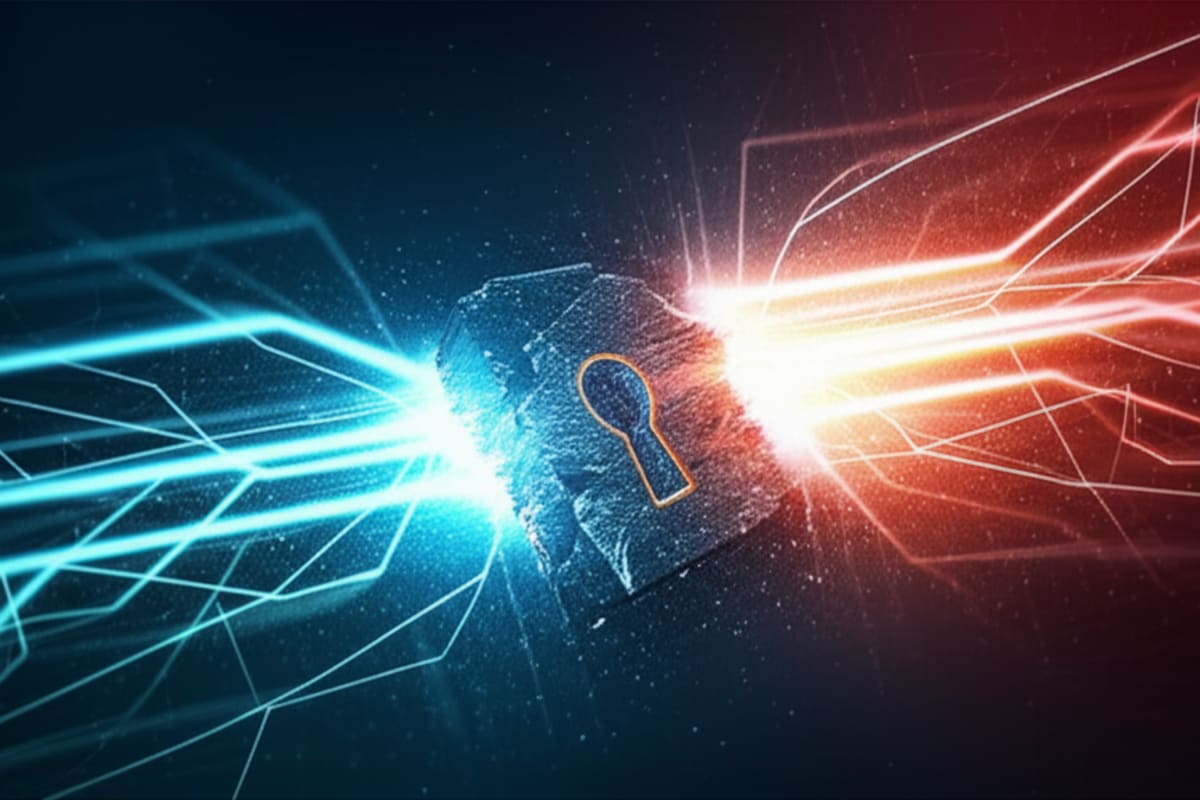Supply Chain Shakedown: Bosses Report Surge in Cyber-Attacks

Imagine the digital arteries of global trade – the intricate, interconnected pathways that bring everything from your morning coffee to your latest smartphone right to your doorstep
Background
Now, imagine those arteries suddenly clogged, or worse, poisoned by malicious actors
It's not some far-fetched plot from a cyberpunk novel; it's the stark, unsettling reality confronting businesses worldwide, and it’s got corporate leaders seriously rattled
A recent survey by the Chartered Institute of Procurement and Supply (CIPS) paints a pretty clear, and frankly, concerning picture
Published just this month, their findings reveal that almost a third of bosses across the globe have reported a significant uptick in cyberattacks targeting their supply chains over the past six months. That’s a massive jump, indicating a rapid escalation of a threat that’s quickly becoming a fundamental business risk, threatening everything from operational continuity to brand reputation.
This isn't just a niche tech problem confined to server rooms anymore; it's a systemic challenge demanding immediate attention from boardrooms to factory floors
The Escalating Threat to Global Supply ChainsRemember the widespread disruptions that crippled operations at corporate titans like Jaguar Land Rover
Those weren't isolated incidents. They were loud, painful wake-up calls, highlighting just how vulnerable these complex, sprawling networks truly are.
It’s not always the big names themselves that hackers go after first; often, it’s the smaller, less-protected links deeper in their supply chains that provide the easiest entry point for cyber criminals looking to wreak havoc or steal valuable data
Think of it as a meticulously designed house – the front door might be iron-clad, but a forgotten window left ajar at the back gives an intruder all they need
So, who’s feeling the heat most keenly. Unsurprisingly, it’s procurement managers.
These are the unsung heroes responsible for sourcing literally everything a company needs to function, from the smallest screw in a factory to the complex software that runs a global logistics network
For them, cyber threats have shot right up their list of concerns, now rubbing shoulders with perennial worries like geopolitical instability, inflation, and raw material shortages
The CIPS survey, conducted in September, pulled data from hundreds of companies spanning industries as diverse as manufacturing, energy, and cutting-edge technology
The message is unambiguous: no sector is immune, and the threat landscape is evolving at a terrifying pace
“The findings are a clear and unequivocal warning: supply chain cybersecurity is no longer an IT issue, but a critical board-level concern.
The ripple effect of a single breach can be catastrophic for businesses and consumers alike
” - CIPS Survey Report Summary, October 2025.
Unmasking the Vulnerabilities: Why the 'Side Gate' MattersThe hacker's playbook for supply chain attacks is, in many ways, quite clever in its malevolence
Why bother trying to breach a fortress when you can simply walk through a poorly guarded side gate. It’s all about leverage.
Attack one weak link, and you potentially compromise an entire network of businesses.
This strategy effectively exploits the 'soft underbelly' of interconnected ecosystems rather than just direct corporate networks, proving highly efficient for cyber adversaries
Cyber criminals aren't just after ransoms anymore, though that remains a popular motive.
They're increasingly after sensitive intellectual property, competitive trade secrets, or simply seeking to cause chaos and disruption for geopolitical ends
It's a multifaceted threat with a wide array of motivations, from state-sponsored espionage to opportunistic ransomware gangs and even activist groups.
These attacks often start with seemingly innocuous phishing attempts targeting employees of a third-party vendor, or by exploiting unpatched software vulnerabilities in a lesser-known supplier
Once inside, they can move laterally through the interconnected systems, eventually reaching the larger, more valuable targets.
This complex web makes detection and attribution incredibly challenging, adding layers of difficulty to an already formidable problem and demanding a proactive, rather than reactive, security posture from all involved
Southeast Asia: A Critical Hub Under SiegeNow, let's bring this closer to home, particularly for those of us operating within, or connected to, Southeast Asia
This region isn't just a picturesque tourist destination; it's a bustling global manufacturing hub, a critical node in countless international supply chains
Think about the sophisticated electronics components meticulously crafted in Malaysia, the vibrant textiles woven in Vietnam, the precision automotive parts manufactured in Thailand, or the vast, intricate logistics networks crisscrossing Singapore and Indonesia
Our economies here are deeply, intrinsically interconnected with the world's biggest brands and markets, making us highly susceptible to global supply chain disruptions
What happens when a European carmaker or an American tech giant gets hit by a ransomware attack that started with a supplier.
More often than not, it means a ripple effect that touches a supplier right here in Southeast Asia
Small and Medium-sized Enterprises (SMEs) in the region, often integral cogs in these larger global machines, are particularly vulnerable.
They might not have the multi-million-dollar cybersecurity budgets, the dedicated IT teams, or the advanced threat intelligence capabilities of their multinational partners
This makes them attractive, softer targets for cyber attackers seeking the path of least resistance and maximum disruption across the entire chain.
Imagine a ransomware attack on a small, family-owned parts manufacturer in Batam, Indonesia, or a data breach at a mid-sized logistics firm in Bangkok, Thailand
The immediate impact is localized, sure, but the fallout.
That could cause significant delays for product shipments across continents, lead to hefty financial losses for multiple companies, and inflict considerable reputational damage on brands far removed from the initial point of compromise
Governments and regional bodies, like ASEAN, aren't blind to this.
They're increasingly scrambling to bolster national and regional cyber resilience strategies, recognizing the diverse digital maturity levels across member states
However, it’s a constant, demanding race against ever-evolving threats and sophisticated adversaries, compounded by the sheer volume of cross-border digital transactions that define our regional economy and its vital contribution to global trade
Beyond the Boardroom: What It Means for YouBeyond the boardrooms and balance sheets, what does this mean for the everyday consumer
Quite a lot, actually. It’s a classic domino effect, and when those dominos fall, they tend to touch everyone.
For instance, a supply chain cyberattack could directly translate into delayed deliveries for your latest online purchases – think electronics, clothing, or even groceries
Moreover, businesses that suffer breaches often incur significant costs in recovery, enhanced security, and potential fines.
These expenses can be passed on to consumers in the form of higher prices, contributing to inflation and impacting household budgets
And perhaps most concerning, a breach that hits a system managing your orders, financial details, or even loyalty points could lead to compromised personal data, exposing individuals to identity theft, financial fraud, and privacy violations
This erosion of trust is a long-term consequence that affects our digital lives profoundly, making us all unwitting participants in this digital battlefield
Building Digital Fortresses: A Call for Collective ResilienceSo, what’s a company to do in this increasingly perilous digital landscape. It’s no longer enough to just lock down your own systems.
The focus has shifted dramatically to what’s often called ‘supply chain integrity.
’ This means rigorous vetting of every single link in your chain, conducting stringent security audits of suppliers – not just once, but regularly – and ensuring continuous monitoring for vulnerabilities
It also demands fostering a pervasive culture of cybersecurity awareness throughout the entire ecosystem, from the CEO down to the shop floor, making every employee a vigilant guardian of digital assets
Furthermore, organizations must have robust, well-tested incident response plans ready to go at a moment's notice
This includes clear communication protocols, rapid containment strategies, and efficient recovery procedures to minimize downtime and damage.
Collaboration is becoming less of an option and more of an absolute necessity; sharing threat intelligence and best practices across industries and even competitors can create a stronger collective defense against a common enemy
Public-private partnerships are also crucial in this fight, providing resources and expertise to smaller entities that might otherwise be overwhelmed and left vulnerable
The digital landscape isn't getting any less complex, and neither are global supply chains
As businesses increasingly rely on interconnected systems, cloud services, and third-party vendors, the ‘attack surface’ – the total number of points where an attacker could try to gain unauthorized access – only continues to expand
This isn't a passing fad or a temporary spike in incidents; it’s a permanent fixture on the risk register for any forward-thinking organization
Companies that fail to take this seriously aren't just taking a gamble with their profits; they’re risking their very existence in an increasingly volatile global economy
It’s a wake-up call, and frankly, it’s one that no business, regardless of size or sector, can afford to snooze through
The future of commerce, and indeed, many of our daily lives, depends on it.
